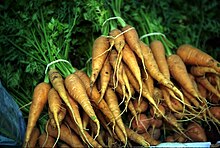turnip

Beet is the botanical name for a storage organ in a plant . It arises from the thickening of the main root including the lowest part of the shoot ( hypocotyl ). The turnip is usually located underground, but can also partly protrude above the ground or be located entirely above it (e.g. with celery ). Beets are only found in allorhiz- rooted dicotyledonous plants.
construction
Although most turnips look very similar, they can have arisen from different parts of the root. The root itself, the hypocotyl or in some cases the base of the shoot can be involved in the structure of the beet . Pure root beets have z. B. the carrot and the sugar beet . Beets, z. Some consist of hypocotyl, have the radish or the beetroot .
A distinction is also made between wood beets , bast beets and beta beets . In wood beet (e.g. radish ) the xylem is developed as a massive storage tissue, in bast beet ( e.g. carrot ) the phloem and in beta beets (cultivated forms of Beta vulgaris ) concentric rings of xylem and phloem or parenchyma .
Cultivated forms of plants that develop beets (selection)

- Carrot ( Daucus carota ), also called yellow turnip
- Radish ( Raphanus sativus )
- Cultivated forms of the beet ( Beta vulgaris ):
- Fodder beet ( Beta vulgaris subsp. Vulgaris var. Crassa )
- Beet ( Beta vulgaris subsp. Vulgaris var. Conditiva )
- Black beet
- Sugar beet ( Beta vulgaris subsp. Vulgaris var. Altissima )
- Turnip ( Brassica rapa subsp. Rapa ), e.g. B. Bavarian turnip , May turnip or Teltower turnip
- Turnip ( Brassica napus subsp. Rapifera or earlier subsp. Napobrassica ) even rutabaga called
- Parsnips ( Pastinaca sativa )
- Root parsley ( Petroselinum crispum convar. Radicosum )
- Celeriac ( Apium graveolens var. Rapaceum )
Diseases and pests
There are some diseases and pests ( parasites ) that specifically affect the beetroot.
Diseases
Pests
Colloquial derivatives
In German usage, “beet” is often understood to mean sugar beet .
Metaphorically , the colloquial word “turnip” describes the human head.
“ Scraping turnips ” is a disapproving gesture , namely the wiping out, which is still found especially in children, by rubbing the index fingers outstretched from the fist against each other.